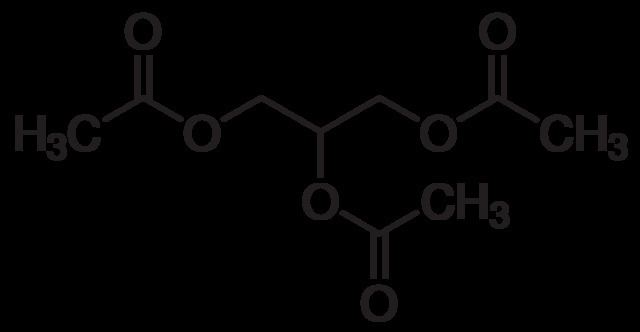Appearance Oily liquid Molar mass 218.21 g/mol Specific heat capacity (C) 389 J/mol·K | Formula C9H14O6 | |
 | ||
Solubility Miscible in EtOH; Soluble in C6H6, (C2H5)2O, acetone Boiling point 259 °C (498 °F; 532 K); at 760 mmHg Refractive index (nD) 1.4301 (20 °C); 1.4294 (24.5 °C) | ||
The triglyceride 1,2,3-triacetoxypropane is more generally known as triacetin and glycerin triacetate. It is the triester of glycerol and acetylating agents, such as acetic acid and acetic anhydride. It is a colorless, viscous and odorless liquid.
Contents
Flavor enhancer triacetin most useful for blending layering
Uses
It is an artificial chemical compound, commonly used as a food additive, for instance as a solvent in flavourings, and for its humectant function, with E number E1518 and Australian approval code A1518. It is used as an excipient in pharmaceutical products, where it is used as a humectant, a plasticizer, and as a solvent.
Triacetin can also be used as a fuel additive as an antiknock agent which can reduce engine knocking in gasoline, and to improve cold and viscosity properties of biodiesel.
In a 1994 report released by five top cigarette companies, triacetin was listed as one of the 599 cigarette additives. The triacetin is applied to the filter as a plasticizer.
It has been considered as a possible source of food energy in artificial food regeneration systems on long space missions. It is believed to be safe to get over half of one's dietary energy from triacetin.
Safety
The US Food and Drug Administration has approved it as Generally Recognized as Safe (GRAS) food additive and included it in the database according to the opinion from the Select Committee On GRAS Substances (SCOGS).
"Three types of acetostearins have been found to be without toxic effects in long-term feeding tests in rats at levels up to 5 g per kg per day. This contrasts with an estimated human consumption of a fraction of a milligram per kg per day. It is recognized that at an even higher feeding level (10 g per kg per day) male rats developed testicular atrophy and female rats, uterine discoloration. However, such a level which would amount to 50 g or more for an infant and 600 g for an adult per day, is vastly higher than would be possible in the consumption of foods to which acetostearins are added for functional purposes."Triacetin is included in the SCOGS database since 1975.
Triacetin was not toxic to animals in studies of exposure through repeated inhalation over a relatively short period.
